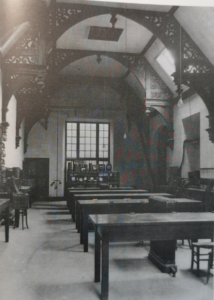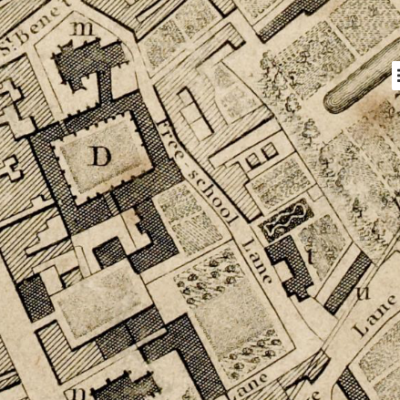Search by topic
- archaeology
- Building of Local Interest
- charity
- church
- crime
- dressmaker
- fire
- Great Eastern Railway
- Listed building
- Mapping Relief
- medieval
- oral history
- poverty
- Public House
- Rattee & Kett
- Religious House
- Roman
- scholar
- school
- Then and Now
- tudor
- women
- work
- world war one
- world war two
Search by text
 Old Botanic Gardens, Downing Street and Free School circa 1850
Old Botanic Gardens, Downing Street and Free School circa 1850Free School, 14 & 15 Free School Lane
History of Old Free School and Almshouses, Free School Lane
1667 12th Feb. Samuel Newton’s son, John starts school.
On the map above dating from circa 1850 no. 24 is the Fitzwilliam Museum and no. 25 is the Free School. No. 31 is probably the old Lecture Room which held a collection of dried Botanical Specimens, as described in 1831.
The 1831 New Guide to … Cambridge describes at this location:
At the corner of free School lane, west of the Botanic Gardens are Perse’s Almshouses. which have a very neat appearance, and a small garden in the front. They were founded in 1615 by Stephen Perse MD of Caius College, for six poor single persons of the age of 40 at least, of the parishes of St Michael and St Edward, or (in default of a competent number) from the parish of St Benedict. The stipend of each inmate in 16l per annum, and the appointment is vested in the Master and Fellows of Caius College.
Adjoining is the Free School which is a plain brick building, with stone dressing and a small arched gateway surmounted by the Founder’s arms. The Master’s House is on the south side of a small court, formed by the various buildings, and a new School Room has been erected within the last few years, in consequence of the room formerly used, being occupied as the temporary reception of the Fitzwilliam Museum.
There then follows a description of the contents of the Fitzwilliam Museum with had been left to the University in the will of Richard Viscount Fitzwilliam who had died in 1816. As the book was written the building of the new Fitzwilliam Museum was about to start.
1851
(14) Peter Mason, 58, head master of Perse Grammar School & Superannuation Master of Naval College Portsmouth, b Norfolk
(15) George Barber, 43, clergyman of Church of England and schoolmaster, b Norfolk
1876 The Perse School Affair
On 2nd May 1876, Josiah Chater, whose eldest son Ernest, had been a pupil in the junior section of the Perse School in Cambridge since September 1874, recorded in his diary:
At the Post Office this evening, Mr Maxwell, one of the the Perse School masters, told be he had had a letter of dismissal from Mr Allen, the Headmaster, because he is a Nonconformist.
Since 1873 Francis Charles Maxwell had been head of the junior department, receiving £150 a year and being allowed to take boarders in his house in Bateman Street. He had been appointed by the previous headmaster, Frederic Heppenstall, but the successor, J B Allen had different ideas. He was opposed to non-conformism amongst his staff and felt that there was ‘a certain difference of social position’ between Maxwell and the rest of the staff.
On 9th June Josiah Chater noted: Maxwell’s dismissal is making a great stir in the country. This was not an understatement and much comment and discussion started in newspapers throughout the country.
Dr Bateson, Master of St John’s College, on behalf of the School governors, tried to calm the mounting hysteria by claiming that the real reason for Maxwell’s dismissal was a poor report on the lower school by independent examiners in 1875. Maxwell defended himself and was support by the former headmaster, Heppenstall, now headmaster of Sedburgh School.
In July there were two petitions, one from Cambridge residents, the other from Nonconformist ministers, calling for the current headmaster’s resignation. However the governors decided that since Allen had been rebuked by them already for his attitude towards a nonconformist teacher, the matter was now closed and Mr Maxwell was free to remain at the school until Christmas.
The controversy was hardly surprising in the light of the Universities Tests Act of 1871, which had freed Nonconformists from many of the disadvantages they had hitherto suffered at Universities. Maxwell left the Perse in September 1875 and became the headmaster of the Manor House School, Clapham Common.
British History Online has this description of the almshouses:
Stephen Perse (d. 1615) founded several important charities including almshouses for six single persons who were to come from certain parishes in Cambridge. The almspeople received allowances from the endowments he left to Caius in trust for all his charities. (fn. 4) The original almshouses built under Perse’s will on the corner of Downing Street and Free School Lane were sold to the University in 1884 and new ones were built in Newnham Road.
Contribute
Do you have any information about the people or places in this article? If so, then please let us know using the Contact page or by emailing capturingcambridge@
License
This work is licensed under CC BY-NC-SA 4.0















